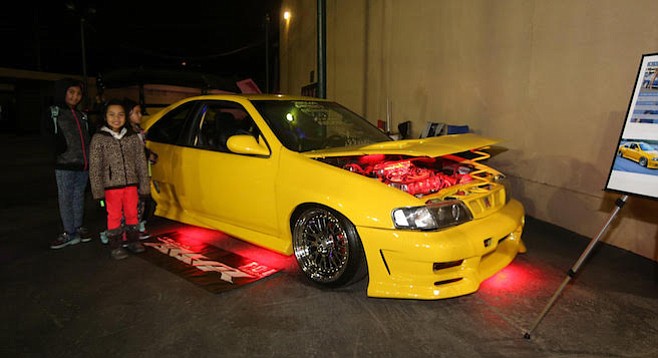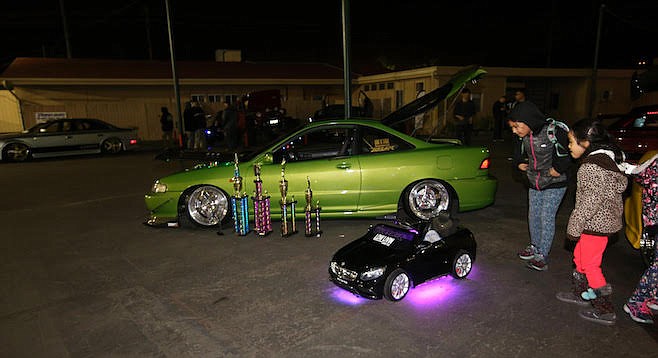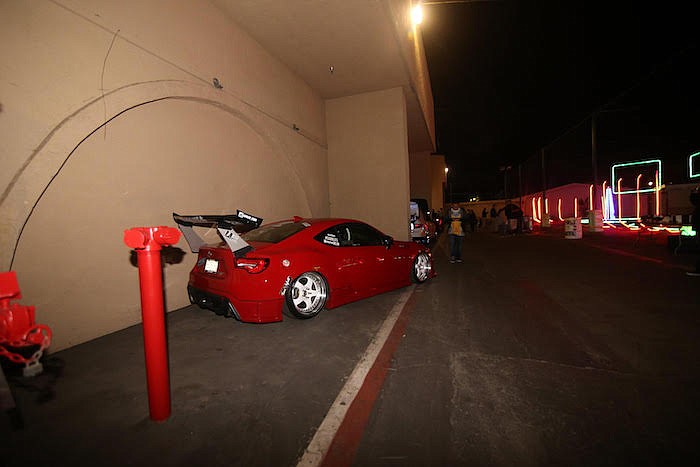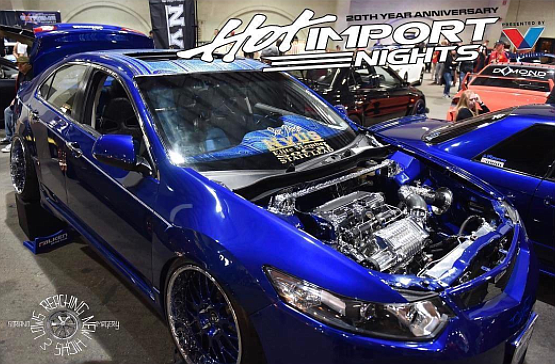 Facebook
Facebook
 X
X
 Instagram
Instagram
 TikTok
TikTok
 Youtube
Youtube

“A lot has changed from the first time I attended these shows,” said Walter Manongdo on February 4 at the Del Mar Fairgrounds. His yellow Nissan race car was posted at the entrance next to his one-year-old son’s electric car — both glowing with neon lights.
Last Saturday, the Hot Import Nights (HIN) 20th-anniversary tour launched from the fairgrounds. The website lists what the event has to offer: “Experience the Ultimate Import Attraction Car Show + Concert + DJ Party + Fashion Show + Lifestyle Event + Import Babes + Music + Miss HIN 2017 + More…” Also, souped-up drones were raced through a neon-lit obstacle course in the back of the venue.

Manongdo, 40, attended the same show in 1999 in the same spot. Back then, the show spread across three halls and their connecting streets and parking lots. Last Saturday, the show took place solely at O’Brien Hall.
“The reason why car shows are not as popular as they use to be is that the judges don’t judge [us] fairly,” Manongdo said. “Social media has also affected [Hot Import Nights] by having less people come out because they can see [event coverage] over the internet and YouTube — instead of paying $25 to come out to the show.”

Lawson Mollica, who does public relations for AEM Electronics, covered the import scene when he was an editor for Turbo Magazine.
“At that time [1990s], the sport compact performance movement was still relatively underground and was not accepted by the mainstream hotrod and tuning community,” Mollica said. “It didn’t matter if you had a Honda, Toyota, Mitsubishi or a VW…everyone was supportive of one another. When HIN started, there was an ‘us against them’ mentality with all import performance enthusiasts. Today, people seem to encapsulate themselves in a bubble of like-minded individuals and actively, vocally shun anything that is outside of their own personal tastes.”
Ira Alani Fouquette Muñoz is an import-tuner who busted through the bubble with his lowrider style. He does not follow the import status quo and still has over 3500 followers on his Instagram page. Muñoz’s 2009 Acura TSX won the Best of Show-Hottest Overall award.

“I think the weather [slight drizzle] was a direct influence on the amount of people that attended,” said Muñoz, “And people don’t want to spend money [for entrance, because] social media show you all the builds as they come along.”
In the past five years, “car-meets” are also blamed by promoters for the slow traffic at car shows. Car-meets are free-of-charge gatherings that are held in open business parking lots.
Manongdo and Muñoz aren’t the only tuners who miss the long (two-hour wait) lines of people who waited to enter the shows. Scott Dean, 39, attended the first Hot Import Nights show in Long Beach in 1998. (He is also a member of Team Hybrid, which won first place in the Hottest Club/Best Team Overall Quality trophy on February 4.)
“The younger enthusiasts were not even born when the first [Hot Import Nights] was going,” Dean said. “[And] there is no more new and wow factors.”
The original (1998–2005) [Hot Import Nights] shows were dark and had lasers and strobe lights that illuminated through the artificial fog and smoke and many of the cars had their hazard lights and undercarriage neon lights on.
“These days all the [venue-ceiling] lights are on, so you lose that nightclub feeling,” Dean said. “People can do some creative things with lighting as well, and I feel like having all the lights on in the hall takes away from that in a big way.”

Manongdo estimated that over 20,000 people would enter the Del Mar Hot Import Nights events back in the “Y2K days.” On the Del Mar Fairgrounds website, the O’Brien, Bing Crosby, and Exhibit halls accommodate approximately 15,800 people (theater capacity) and cost $23,200 to rent for two days (two-day minimum). The adjoining parking lots cost extra.
Last Saturday night, Manongdo estimated that “approximately 2000 people rolled through.”
“Each year since 2015 [attendance] has increased and I hope it continues to do so,” Dean said. “I want to see all three halls at Del Mar filled [again] soon.” He estimated approximately 350–400 cars entered last Saturday night. The owners were charged between $41 and $50 to compete.
Mollica also remains optimistic. “If this day ever comes, then I think there will be a resurgence in these types of events, because at their core they are designed to bring together sub segments of a niche into a larger community.”


“A lot has changed from the first time I attended these shows,” said Walter Manongdo on February 4 at the Del Mar Fairgrounds. His yellow Nissan race car was posted at the entrance next to his one-year-old son’s electric car — both glowing with neon lights.
Last Saturday, the Hot Import Nights (HIN) 20th-anniversary tour launched from the fairgrounds. The website lists what the event has to offer: “Experience the Ultimate Import Attraction Car Show + Concert + DJ Party + Fashion Show + Lifestyle Event + Import Babes + Music + Miss HIN 2017 + More…” Also, souped-up drones were raced through a neon-lit obstacle course in the back of the venue.

Manongdo, 40, attended the same show in 1999 in the same spot. Back then, the show spread across three halls and their connecting streets and parking lots. Last Saturday, the show took place solely at O’Brien Hall.
“The reason why car shows are not as popular as they use to be is that the judges don’t judge [us] fairly,” Manongdo said. “Social media has also affected [Hot Import Nights] by having less people come out because they can see [event coverage] over the internet and YouTube — instead of paying $25 to come out to the show.”

Lawson Mollica, who does public relations for AEM Electronics, covered the import scene when he was an editor for Turbo Magazine.
“At that time [1990s], the sport compact performance movement was still relatively underground and was not accepted by the mainstream hotrod and tuning community,” Mollica said. “It didn’t matter if you had a Honda, Toyota, Mitsubishi or a VW…everyone was supportive of one another. When HIN started, there was an ‘us against them’ mentality with all import performance enthusiasts. Today, people seem to encapsulate themselves in a bubble of like-minded individuals and actively, vocally shun anything that is outside of their own personal tastes.”
Ira Alani Fouquette Muñoz is an import-tuner who busted through the bubble with his lowrider style. He does not follow the import status quo and still has over 3500 followers on his Instagram page. Muñoz’s 2009 Acura TSX won the Best of Show-Hottest Overall award.

“I think the weather [slight drizzle] was a direct influence on the amount of people that attended,” said Muñoz, “And people don’t want to spend money [for entrance, because] social media show you all the builds as they come along.”
In the past five years, “car-meets” are also blamed by promoters for the slow traffic at car shows. Car-meets are free-of-charge gatherings that are held in open business parking lots.
Manongdo and Muñoz aren’t the only tuners who miss the long (two-hour wait) lines of people who waited to enter the shows. Scott Dean, 39, attended the first Hot Import Nights show in Long Beach in 1998. (He is also a member of Team Hybrid, which won first place in the Hottest Club/Best Team Overall Quality trophy on February 4.)
“The younger enthusiasts were not even born when the first [Hot Import Nights] was going,” Dean said. “[And] there is no more new and wow factors.”
The original (1998–2005) [Hot Import Nights] shows were dark and had lasers and strobe lights that illuminated through the artificial fog and smoke and many of the cars had their hazard lights and undercarriage neon lights on.
“These days all the [venue-ceiling] lights are on, so you lose that nightclub feeling,” Dean said. “People can do some creative things with lighting as well, and I feel like having all the lights on in the hall takes away from that in a big way.”

Manongdo estimated that over 20,000 people would enter the Del Mar Hot Import Nights events back in the “Y2K days.” On the Del Mar Fairgrounds website, the O’Brien, Bing Crosby, and Exhibit halls accommodate approximately 15,800 people (theater capacity) and cost $23,200 to rent for two days (two-day minimum). The adjoining parking lots cost extra.
Last Saturday night, Manongdo estimated that “approximately 2000 people rolled through.”
“Each year since 2015 [attendance] has increased and I hope it continues to do so,” Dean said. “I want to see all three halls at Del Mar filled [again] soon.” He estimated approximately 350–400 cars entered last Saturday night. The owners were charged between $41 and $50 to compete.
Mollica also remains optimistic. “If this day ever comes, then I think there will be a resurgence in these types of events, because at their core they are designed to bring together sub segments of a niche into a larger community.”
Comments